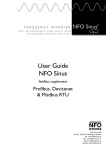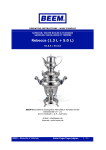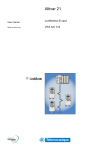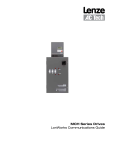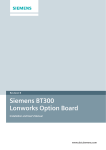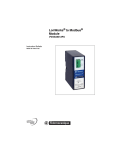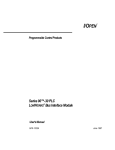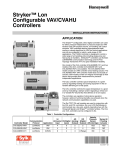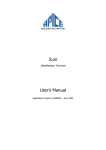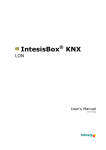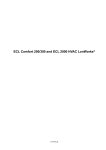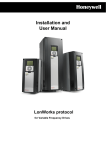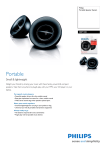Download User Manual Appendix: NFO Sinus with
Transcript
User Manual Appendix: NFO Sinus with LonWorks option NFO Drives AB Huvudkontor: Box 35, SE-376 23 Svängsta, Sweden Tel: +46 (0)454-370 29 Fax: +46 (0)454-32 24 14 Email: [email protected] Internet: www.nfodrives.se Marknadsavdelning: Forskningsbyn IDEON SE-223 70 Lund, Sweden Tel: +46 (0)46-286 29 29 Fax: +46 (0)46-286 29 25 Table of contents 1 Preface....................................................................................................................................................................... 3 2 NFO Sinus with LonWorks option..................................................................................................................... 3 3 Introduction to LonWorks................................................................................................................................... 4 3.1 Nodes .......................................................................................................................................................... 4 3.2 Network variables (SNVT’s)................................................................................................................... 4 3.3 Technical features of LonWorks ........................................................................................................... 5 4 NFO Sinus Overview ............................................................................................................................................. 7 4.1 Drive configuration................................................................................................................................... 7 4.2 Physical interfaces ..................................................................................................................................... 7 4.2.1 Network cabling ....................................................................................................................... 8 4.2.2 Indication LED’s ........................................................................................................................ 8 4.2.3 Service pin .................................................................................................................................. 9 4.3 Configuration ............................................................................................................................................. 9 4.3.1 Baudrate...................................................................................................................................... 9 4.3.2 Installation .................................................................................................................................. 9 4.4 Operating the drive via LonMark profile ...........................................................................................10 5 Network Variables................................................................................................................................................11 5.1 Input Network Variables - NVI’s .........................................................................................................11 5.1.1 Node object request..............................................................................................................11 5.1.2 Drive Speed Setpoint.............................................................................................................11 5.1.3 Speed Setpoint Scaling ...........................................................................................................13 5.1.4 Set Drive Frequency ..............................................................................................................13 5.1.5 Profidrive control word ........................................................................................................13 5.2 Output Network Variables - NVO’s ..................................................................................................14 5.2.1 Node Object Status ...............................................................................................................14 5.2.2 Drive Status .............................................................................................................................14 5.2.3 Drive Speed .............................................................................................................................14 5.2.4 Output Frequency ..................................................................................................................15 5.3 Configuration Properties – NCI’s .......................................................................................................15 5.3.1 Send Heartbeat .......................................................................................................................15 5.3.2 Receive Heartbeat ..................................................................................................................16 5.3.3 Minimum Send Time ..............................................................................................................16 5.3.4 Location Label .........................................................................................................................16 5.3.5 Nominal Speed ........................................................................................................................17 5.3.6 Nominal Frequency ................................................................................................................17 5.3.7 Max Frequency ........................................................................................................................17 5.3.8 Minimum Speed.......................................................................................................................18 5.3.9 Maximum Speed......................................................................................................................18 5.3.10 Ramp Up Time ........................................................................................................................18 5.3.11 Ramp Down Time ..................................................................................................................19 5.3.12 Speed setpoint scaling default value....................................................................................19 6 Conditions for operating.....................................................................................................................................20 6.1.1 General .....................................................................................................................................20 6.1.2 Start ...........................................................................................................................................20 6.1.3 Stop............................................................................................................................................20 6.1.4 Reset fault.................................................................................................................................20 6.1.5 Prioritizing between nciMinOutTm and nciSendHrtBt ..................................................20 NFO Drives AB. Version 1.0 2 1 Preface The data and illustrations found in this document are not binding. We reserve the right to modify our products in line with our policy of continuous product development. The information in this document is subject to change without notice and should not be considered as a commitment by NFO Drives AB. NFO Drives AB assumes no responsibility for any errors that may appear in this document. Echelon, LON, LonWorks, Neuron, 3120, 3150, LonTalk, LonBuilder, LonUsers, LonManager, the Echelon logo are registered trademarks of Echelon Corporation in the US and other countries. LonLink, LonMaker, LonMark, LONews, LonSupport, Nodebuilder, the LonMark logo and the LonUsers logo are trademarks of Echelon Corporation. 2 NFO Sinus with LonWorks option The LonWorks option gives an instant connection between the NFO Sinus drive and a LonWorks network. The drive communicates according to the LonWorks Protocol Standard ANSI/EIA 709.1-A-1999. This means that it can communicate with all LonWorks nodes that comply with this standard, but it does not necessarily mean that all services available in the LonWorks standard are supported. In a control system the drive will act as a node that can be read and written to, from any other LonWorks node that has SNVT’s that corresponds to the one in the drive. NFO Drives AB. Version 1.0 3 3 Introduction to LonWorks The LONWORKS technology is a complete platform for implementing control network systems. These networks consists of intelligent control devices or nodes that interact with their environment and communicate with each other using a common, message based protocol (LonTalk®). A LONWORKS network can consist of up to 32.385 nodes divided into 255 subnets (127 nodes/subnet). 3.1 Nodes Nodes are objects that interact with physically attached I/O devices and communicating over a network using the LonTalk protocol. Each node in the network contains embedded intelligence that implements the protocol and performs control functions (handling of I/O signals). No central control or master-slave architecture is needed and therefor a LonWorks network often is called ”distributed I/O network”. Each node includes a physical interface, transceiver that interface with the communication media. NFO Sinus uses the FTT-10 A (Free Topology Twisted Pair) from Echelon Corporation. This is the most commonly used twisted-pair media in building automation and this architecture supports star, bus, and loop wiring. The FTT-10A transceiver connects to a twisted pair cable with a baudrate of 78kbps. The FTT-10A transceiver appears as high impedance to the network when un-powered, and does not interfere with network communications when powered down. 3.2 Network variables (SNVT’s) A network variable is an object on one node that can be connected to one or more network variables on one or more additional nodes. A node’s network variables define its inputs and output from a network point of view and allow the sharing of data in a distributed application. Whenever a program writes into one of its output network variables, the new value of the network variable is propagated across the network to all nodes with input network variables connected to that output network variable. For example to turn on the light over a LonWorks network, a switch node has its output network variable (NV_Switch) connected or bound to the variable NV_Switch on the lamp node. When the switch is activated, the network variable is propagated over the network and received in the lamp node, which turn on the light. See Picture 1. NFO Drives AB. Version 1.0 4 Switch Node NV_Switch NV_Switch Lamp Node Picture 1 The LonMark organisation has approved a number of network variables that represent different types of standard data representation, for example temperature, pressure, percent, voltage. They are named Standard Network Variables or SNVT’s and are listed in the ”SNVT Master List and Programmers Guide” from Echelon Corporation. A SNVT contains information about type, resolution and range. The LonMark association defines objects that can be described as a group of SNVT’s used for a specific application. Note that network variables also can be defined by the user as non-standard and they are usually called just network variables or NV’s. 3.3 Technical features of LonWorks Summary Technical Features LonWorks Transmission Technique: Medium Access: - Free topology (FTT-10A) twisted pair cable - Transmission rate 78kbits/s - Predictive CSMA Max Bus length: Data types: - Bus up to 2000 m - Peer-to-peer communication Max. node-to-node distance: - 500m Max amount of nodes: - 32.385 nodes divided as 127 nodes/subnet, 255 subnets/domain. Table 1 NFO Drives AB. Version 1.0 5 Picture 2 NFO Drives AB. Version 1.0 6 4 NFO Sinus Overview This section contains all necessary information to start-up and configures the NFO Sinus drive with LonWorks. 4.1 Drive configuration To be able to control NFO Sinus from the LonWorks network the following parameters has to be set in the drive. Parameter Mode in the Mode menue has to be set to the value Freque. Parameter OpMode in the Freque menue has to be set to the value AnyBus. With these settins the drive will automatically enter fieldbus control at startup. NFO Sinus with LonWorks option should have these settings at delivery. The drive status, shown on the display, will say “Bus Run” or “Bus Stby” depending on if the motor ouyput is activated or not. The display will also show the actual motor frequency. The LonWorks control can be broken at any time by pressing <STOP> on the keyboard, this will immediately release the motor whereon the disply will say “Stop”. To reenter LonWorks control, press <SHIFT>+<STOP>. Note that the RUN-signal on the terminal has to be activated to give ability to start the motor from the LonWorks network. For information on hows to change parameter values and activates RUN-signal, refeer to the ordinary user manual. 4.2 Physical interfaces NFO Sinus connects to the LonWorks network with a 5-pin connector placed on the left side of the drive. Next to the network connector there are three indication LED´s and a service pusch button, as shown in Picture 3. NFO Drives AB. Version 1.0 7 1 2 3 4 5 WINK SERVICE POWER Bus connector Indication LED´s Service pin Picture 3 4.2.1 Network cabling For the pin layout of the network connector, refer to Table 2. NOTE: NET A and NET B connection is not polarity sensitive. Screw Terminal Description 5 - 4 Net A 3 Net B 2 - 1 Shield Table 2 Pin function of the fieldbus connectors. For detailed information about recommended cables for a LonWorks network, please see the FTT-10A Free Topology Transceiver User’s Guide (doc.id.078-0156-01F) available at http://www.echelon.com Below are some recommended cables: • • • • • Belden 85102, unshielded Belden 8471, unshielded Level IV 22AWG, unshielded JY (St) Y 2x2x0.8, shielded TIA568A Cat.5 24AWG To be able to communicate in a noisy environment, and to fulfil all EMC-requirements, it’s important that a shielded cable is used, and that proper grounding is provided. 4.2.2 Indication LED’s As described in Picture 3, there are three indication LED´s associated to the LonWorks connection placed next to the network connector. NFO Drives AB. Version 1.0 8 See LONWORKS documentation for more information about the Service LED and wink command. Table 1 shows the function of the LED indicators. LED COLOUR FUNCTION POWER GREEN Turned Off: Power is off Lit: Power is on LONWORKS GREEN Flashing Service LED This node has an application but is not yet installed in a network (unconfigured). Turned off This node is configured and installed in a network. Lit This node is unconfigured and applicationless. Indicates errors detected by the Neuron Self-Test routine. WINK RED Used when a node is ”winked”. Application specific implementation. Table 1 4.2.3 Service pin NFO Sinus provides a Service pushbutton (S1), which is used during the installation phase to identify the node. See Picture 3 for location of the pushbutton. 4.3 Configuration 4.3.1 Baudrate The adapter has a fixed baudrate of 78kbps (FTT-10A) 4.3.2 Installation NFO Sinus installed in a LonWorks network using any standard LonWorks installation tool (e.g. “LonMaker for Windows” from Echelon). NFO Drives AB. Version 1.0 9 4.4 Operating the drive via LonMark profile A LonMark profile defines a functional profile for a node communicating with others. A LonMark profile specifies which SNVT’s and SCPT’s to be used and also a semantic meaning about the information being communicated. When a profile is implemented in a node, it is called a LonMark Object. One node can have several objects implemented. NFO Sinus has two objects, a node-object and a drive-object. The node-object is used to control the other objects in a node. Node Object nv1 nviRequest SNVT_obj_request Mandatory Network Variables nv2 nvoStatus SNVT_obj_status Picture 4 NFO Drives AB. Version 1.0 10 5 Network Variables 5.1 Input Network Variables - NVI’s 5.1.1 Node object request Network input SNVT_obj_request nviObjRequest; This input is used to enable control commands and updates from network. The valid identification numbers must be used. The valid numbers are 0 and 1. The status of the node is reported in nvoObjStatus, see chap. 5.2.1. RQ_UPDATE_STATUS updates nvoObjStatus. RQ_CLEAR_STATUS clears nvoObjStatus. RQ_CLEAR_ALARM resets a fault in the drive. RQ_REPORT_MASK reports supported requests in nvoObjStatus. RQ_DISABLED disables settings of nviDrvSpeedStpt and nviDrvSpeedScale. It will stop the drive. RQ_NORMAL and RQ_ENABLE have the same function. These two requests enable settings of nviDrvSpeedStpt and nviDrvSpeedScale again, if they were disabled by RQ_DISABLED. Speed settings need to be updated to start the drive again if disabled. If RQ_SELF_TEST, RQ_OVERRIDE, RQ_RMV_OVERRIDE, RQ_ALARM_NOTIFY_ENABLED, RQ_ALARM_NOTIFY_DISABLED, RQ_PROGRAM, RQ_MANUAL_CTRL, RQ_REMOTE_CTRL, or RQ_NUL is requested, the invalid_request bit will be set in nvoObjStatus. If RQ_DISABLED, RQ_NORMAL or RQ_ENABLE is set, this state will be stored. This means that nviObjRequest can first be set to RQ_DISABLED and then e.g. RQ_REPORT_MASK. Then the object will still be disabled and reported masks will be shown in nvoObjStatus. 5.1.2 Drive Speed Setpoint Network input SNVT_switch nviDrvSpeedStpt. This input network variable provides a low-resolution speed setpoint. When nviDrvSpeedStpt.State is set to another value then 1 the drive is stopped, if not nviProfiDrvCw is used. Valid Range NFO Drives AB. Version 1.0 11 nviProfiDrvCw NviDrvFreqStpt State Percent value Requested Speed 0 N/a STOPPED (0.0 to 100.0%) * 32767 or -32768 1 0.0 to 100.0% nviDrvSpeedScale * nciNmlSpeed [rpm] 0 -32767 to 32766 0xFF N/a AUTO (Invalid) 0 N/a STOPPED 1 N/a 0xFF N/a depend on 0.0 to 100.0% nviProfiDrvCw. Not 0 depend on nviProfiDrvCw. AUTO (Invalid) nviDrvSpeedScale * nciNmlSpeed [rpm] N/a, Start/Stop -32767 to 32766 [Hz] (0.0 to 100.0%) * N/a, Start/Stop 32767 or -32768 nviDrvFreqStpt/10 N/a nviDrvFreqStpt/10 [Hz]. Table 2 Note: Requested speed will not be greater then the value defined by nciMaxSpeed or less then the value defined by nciMinSpeed if not nviDrvFreqStpt is used. If nviDrvFreqStpt is used then nciMaxSpeed and nciMinSpeed have no function. Default value: Default value is AUTO (state = 0xFF). This value will be adapted at power-up. This network variable input may use the Receive Heartbeat function depending on if Receive Heartbeat function is setup for use. The actual value of drive speed does also depend on nviDrvSpeedScale. NFO Drives AB. Version 1.0 12 5.1.3 Speed Setpoint Scaling Network input SNVT_lev_percent nviDrvSpeedScale; This input network variable provides scaling for nviDrvSpdStpt. For example if nviDrvSpeedStpt value is 100% and nviDrvSpeedScale value is -150%, then actual speed setpoint value is -150% meaning reverse 1,5 times nominal speed. The requested speed will not be greater then the value defined by nciMaxSpeed or less then the value defined by nciMinSpeed. Valid Range: -163.84->163.83% Default Value: Is defined by nciDrvSpeedScale. 5.1.4 Drive Frequency Network input SNVT_count_inc nviDrvFreqStpt; This input network variable sets drive frequency. The value set is ten times greater then the frequency set to drive. This is to get higher resolution. 10 set in parameter is 1,0 Hz in drive. If set within valid range it overrides nviDrvSpeedStpt and nviDrvSpeedScale settings. If set above valid range nviDrvSpeedStpt and nviDrvSpeedScale is in control of drive frequency output. The frequencies set have to be with in valid range in the drive as well, or they will not be used. Valid Range: -32767 to 32766 (-3276,7 to 3276,6 Hz) to set drive frequency with nviDrvFreqStpt. -32768 or 32767 to set drive frequency with viDrvSpeedStpt and nviDrvSpeedScale. Default Value: 32767. Parameter is not in control over frequency setting in drive. 5.1.5 Profidrive control word Network input SNVT_state nviProfidriveCW; Parameter to control the drive in accordnce with PROFIBUS Profile for variable speed drives, PROFIDRIVE. If this parameter is set to other value then 0 data is used as the PROFIDRIVE control word, it will override the values of, nviRequest (for requests RQ_ENABLE, RQ_NORMAL, RQ_DISABLED and RQ_CLEAR_ALARM) and nviSpeedStpt.state. Default: 0 (zero), not in use. NFO Drives AB. Version 1.0 13 5.2 Output Network Variables - NVO’s All output variables, with the exception of nvoObjStatus, will be updated when changed if not nciMinOutTm or nciSndHrtBt is set greater then 0. NvoObjStatus will be updated when a new request is done in nviObjRequest. 5.2.1 Node Object Status Network output SNVT_obj_status nvoObjStatus This nvo reports node object status. It will be updated every time status changes. See chap. 5.1.1 for different requests. Invalid_request The node has been asked for an unsupported request. Report_mask Report supported fields. Comm_failure No contact with the drive. In_alarm The drive has faulted. Disabled NviObjRequest have received a RQ_DISABLED request. Settings of nviSpeedScale and nviSpeedStpt is disabled. Invalid ID If another identification number then 0 and 1have been set in request by SNVT nviObjRequest. The request will not be carried out. 5.2.2 Drive Status Network output SNVT_state nvoDrvStatus; This output network variable provides the status of the drive in accordnce with PROFIBUS Profile for variable speed drives, PROFIDRIVE. 5.2.3 Drive Speed Network output SNVT_level_percent nvoDrvSpeed; This output network variable provides the speed of the drive as a percentage of the nominal speed. Range: -163.84% .. 163.83% (0.005% or 50 ppm). The value 0x7FFF represents invalid data. NFO Drives AB. Version 1.0 14 5.2.4 Output Frequency Network output SNVT_count_inc nvoDrvFreq; Output frequency, ten times greater then the output frequency in Hz. This is to get higher resolution. Range: -32767 .. 32766 (0.1 Hz). The values –32768 and 32766 represents invalid data. 5.3 Configuration Properties – NCI’s Network Configuration Input variables. Nci’s keep their values after a power cycle. The default values for the Nci’s are in a range that the drive ignores them. The drive uses its old internal values. If an nci has a corresponding parameter in the drive, the drive parameter will be written to automatically at some occasions, apart from when the nci is updated from another network node. These occasions are when node is brought online and when the drive is power-cycled. To ensure that drive parameters that are written to by nci’s have the values intended, set them from the LonWorks network. If e.g. Ramp up time is set from the panel to 3 sec and nciRampUpTm is 20 sec, Ramp up time will be set to 3 sec only until any of the occasions above occurs. 5.3.1 Send Heartbeat Network input config SNVT_time_sec nciSndHrtBt; This input configuration network variable provides the maximum send time for the variable nvoDrvSpeed. Range: 0.0 to 6,553.4 seconds. The value 0.0 disables the Send Heartbeat mechanism. Default value: 0.0. NFO Drives AB. Version 1.0 15 5.3.2 Receive Heartbeat Network input config SNVT_time_sec nciRcvHrtBt; This configuration property is used to control the maximum time that can elapse between updates of the input network variable nviDrvSpeedStpt before a timeout occures. If this happens for any reason, e.g. if the buscable is disconnected, the option board will fault the drive. Range: 0.0 to 6,553.4 seconds. The value 0.0 disables the Receive Heartbeat mechanism. Default value: 0.0. 5.3.3 Minimum Send Time Network input config SNVT_time_sec nciMinOutTm; This input configuration network variable control the minimum period of time that expires before the network output variables can be resent. This is good for limiting use of bandwidth on the LonWorks network. Range: 0.0 to 6,553.4 seconds. The value 0.0 disables transmission limiting. Default value: 0.0. 5.3.4 Location Label Network input config SNVT_str_asc nciLocation; This configuration property can optionally be used to provide more descriptive physical location information than can be provided by the Neuron Chip’s 6-byte location string. The location relates to the object and not to the node. Default value: Empty spaces. NFO Drives AB. Version 1.0 16 5.3.5 Nominal Speed Network input config SNVT_rpm nciNmlSpeed; This configuration parameter is used to provide the nominal speed of the motor. Range: 0 .. 32766 rpm. The value 32767 represents invalid data, ignored by the drive. Default value: 32767. 5.3.6 Nominal Frequency Network input config SNVT_freq_hz nciNmlFreq; This configuration parameter is used to provide the nominal frequency of the motor. Range: 0 .. 3276,6 Hz. The value 3276,7 represents invalid data, ignored by the drive. Default value: 3276,7. 5.3.7 Max Frequency Network input config SNVT_freq_hz nciMaxFreq; This configuration property is used to provide the maximum frequency of the motor. Range: 0 .. 3276,6 Hz. The value 3276,7 represents invalid data, ignored by the drive. Default value: 3276,7. NFO Drives AB. Version 1.0 17 5.3.8 Minimum Speed Network input config SNVT_lev_percent nciMinSpeed; This configuration property is used to define the minimum speed of a motor. Its value is entered as a percent of nominal speed, as defined by the Nominal Speed (nciNmlSpeed) configuration value. If nciNmlSpeed = 1420 rpm and nciMinSpeed = 10%, the minimum speed is 142 rpm. Range: The value of the minimum speed must be validated against the value of the minimum speed as follows. -163.84 ≤ minimum speed ≤ maximum speed ≤ 163.83 If minimum speed is set higher then maximum speed that setting will not take effect. The old value is used. Default value: 0% 5.3.9 Maximum Speed Network input config SNVT_lev_percent nciMaxSpeed; This configuration property is used to define the maximum speed of a motor. Its value is entered as a percent of nominal speed, as defined by the Nominal Speed (nciNmlSpeed) configuration value. If nciNmlSpeed = 1420 rpm and nciMaxSpeed = 125%, the maximum speed is 1775 rpm. Range: The value of the maximum speed must be validated against the value of the minimum speed as follows. -163.84 ≤ minimum speed ≤ maximum speed ≤ 163.83 If maximum speed is set lower then minimum speed that setting will not take effect. The old value is used. Default value: 100% 5.3.10 Ramp Up Time Network input config SNVT_time_sec nciRampUpTm; This configuration property is used to set the ramp up time. Default value: 6553,5 Sec. Value ignored by drive. NFO Drives AB. Version 1.0 18 5.3.11 Ramp Down Time Network input config SNVT_time_sec nciRampDownTm; This configuration property is used to set the ramp down time. Default value: 6553,5 Sec. Value ignored by drive. 5.3.12 Speed setpoint scaling default value Network input config SNVT_lev_percent nciDrvSpeedScale This parameter is used for setting its value to nviDrvSpeedScale (see chapter 5.1.3) on power-cycle, offline-online and reset event. Range: -163.84% .. 163.83% Default value: 0 NFO Drives AB. Version 1.0 19 6 Conditions for operating This section will describe what conditions there are for performing some common actions and how the combination of SNVT’s and SCPT’s will affect the operation of the drive. 6.1.1 General Communication and configuration of NFO Sinus drive must be set up and function properly. 6.1.2 Start The drive will run if nviDrvSpeedStpt.state is set to 1. In nviObjRequest RQ_NORMAL or RQ_ENABLE has to be requested more recently then RQ_DISABLED. If the nviProfidriveCw is used (value not 0) the settings above has no effect on the drive. Node has to be online. 6.1.3 Stop The drive will stop and use the normal stop ramp if NviSpeedStpt.state is set to any value different from 1 or if node is brought offline. The drive will also stop if RQ_DISABLED is requested in nviObjRequest. If the nviProfidriveCw is used (value not 0) the settings above have no effect on the drive. 6.1.4 Reset fault If an error has occurred the NFO Sinus drive will be faulted. By removing the reason for the fault and setting nviObjRequest to RQ_CLEAR_ALARM it can be reset over the LonWorks network, if not the nviProfidriveCw is used. 6.1.5 Prioritizing between nciMinOutTm and nciSendHrtBt The nciSendHrtBt will have prioritizing over nciMinOutTm. This will mean that heartbeats will be sent as often as specified in nciSendHrtBt even if nciMinOutTm has a longer time set. NFO Drives AB. Version 1.0 20




















